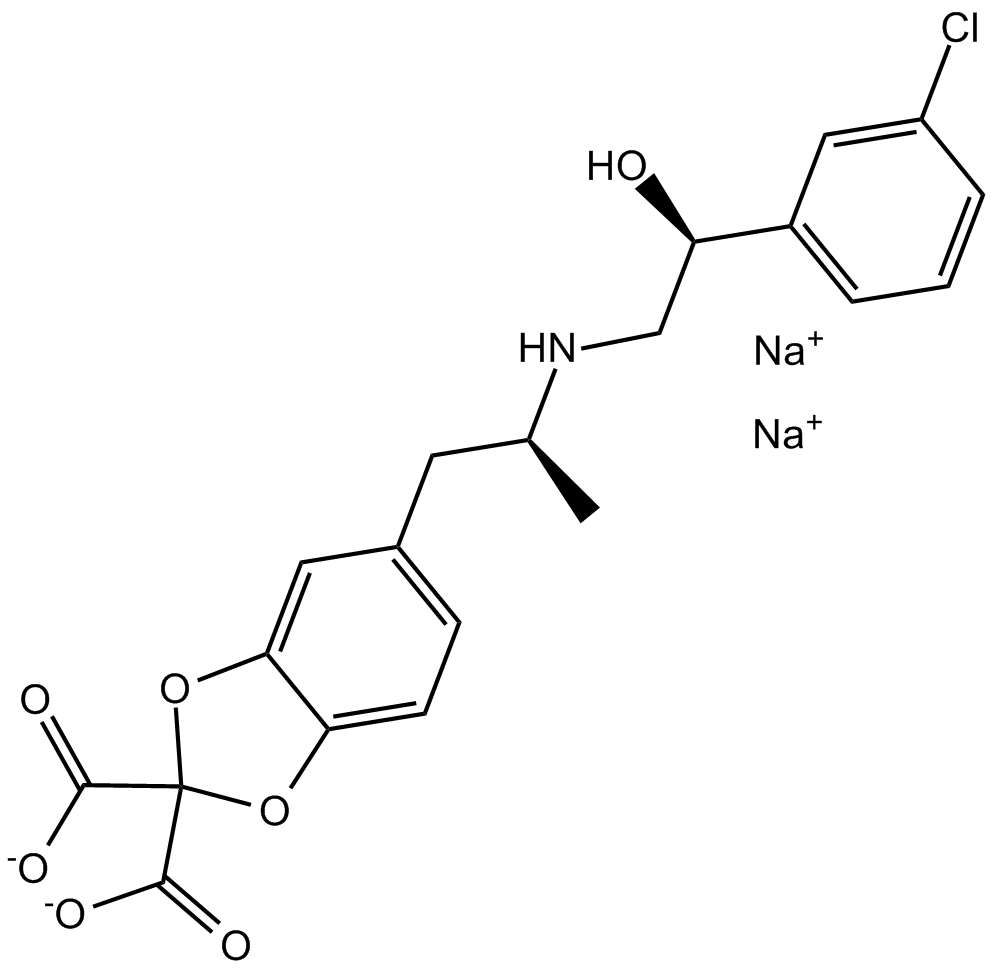CL 316,243 (disodium salt) |
| Catalog No.GC43276 |
Un agoniste sélectif des récepteurs β3 adrénergiques murins
Products are for research use only. Not for human use. We do not sell to patients.

Cas No.: 151126-84-0,138908-40-4
Sample solution is provided at 25 µL, 10mM.
EC50: (3.0±0.3) X 10-8 M for β3 adrenoceptor [1].
Benzodioxole-containing phenethanolamine CL-316,243 is a murine-selective β3 adrenoceptor agonist which can correct obesity and elevated blood glucose in diabetic rodents, which offers an exciting possibility for the treatment of non-insulin-dependent diabetes as well as obesity without undesired β-mediated side effects [3]. β3 adrenoceptor is located mainly in adipose tissue and is involved in the regulation of lipolysis and thermogenesis.
In vitro: The compound was a potent stimulant of rat adipocyte lipolysis (β3 effect, EC50 = (3.0±0.3) X 10-8 M), had no effect on the rate of contraction of guinea pig atria (β1 effect, EC50 > 10-4 M), and had only a very limited ability to inhibit insulin-stimulated [14C] glucose incorporation into glycogen in isolated rat soleus muacle (β2 effect, IC50 = (3.0±1.0) X 10-5 M) [1].
In vivo: In rat, CL-316,243 treatment resulted in increased growth rates and significant changes in food consumption at the end of the 10-day treatment period. CL-316,243 treatment increased insulin responsiveness and sensitivity in non-insulin-resistant rodent species. The CL-316,243 induced increases in whole-body glucose disposal were due entirely to increases in adipose tissue glucose uptake, while muscle glucose uptake remained unaltered [2].
Clinical trial: So far, no clinical study has been conducted.
[1]. Bloom, J.D., Dutia, M.D., Johnson, B.D., et al. Disodium (R,R)-5-[2-[[2-(3-chlorophenyl)-2-hydroxyethyl]-amino] propyl]-1,3-benzodioxole-2,2-dicarboxylate (CL 316,243). A potent β-adrenergic agonist virtually specific for β3 receptors. A promising antidiabetic and antiobesity agent. Journal of Medicinal Chemistry 35(16), 3081-3084 (1992).
[2]. Baker, J.G. The selectivity of β-adrenoceptor antagonists at the human β1, β2 and β3 adrenoceptors. Br. J. Pharmacol. 144(3), 317-322 (2005).
[3]. Guerra, C., Koza, R.A., Yamashita, H., et al. Emergence of brown adipocytes in white fat in mice is under genetic control. Effects on body weight and adiposity. Journal of Clinical Investigation 102(2), 412-420 (1998).
[4]. MacPherson, R.E.K., Castellani, L., Bueadoin, M.S., et al. Evidence for fatty acids mediating CL 316,243-induced reductions in blood glucose in mice. American Journal of Physiology.Endocrinology and Metabolism 307(7), E563-E570 (2014).
Average Rating: 5 (Based on Reviews and 20 reference(s) in Google Scholar.)
GLPBIO products are for RESEARCH USE ONLY. Please make sure your review or question is research based.
Required fields are marked with *




